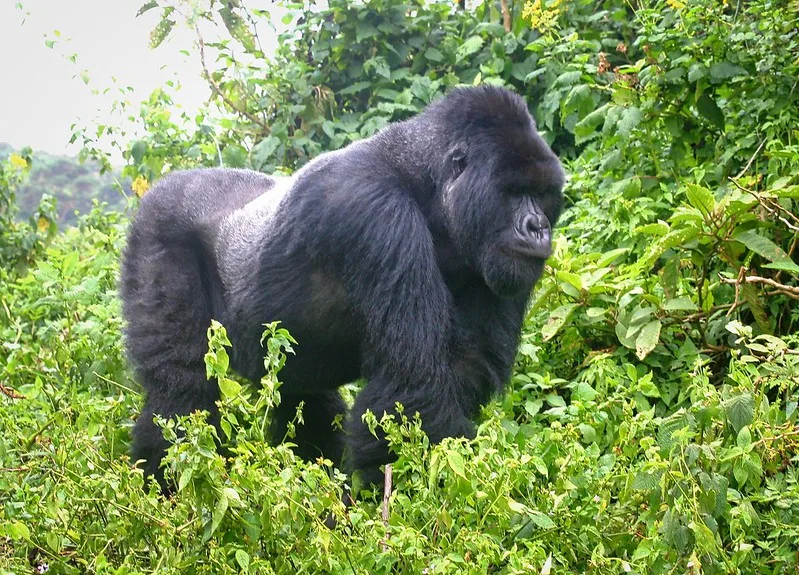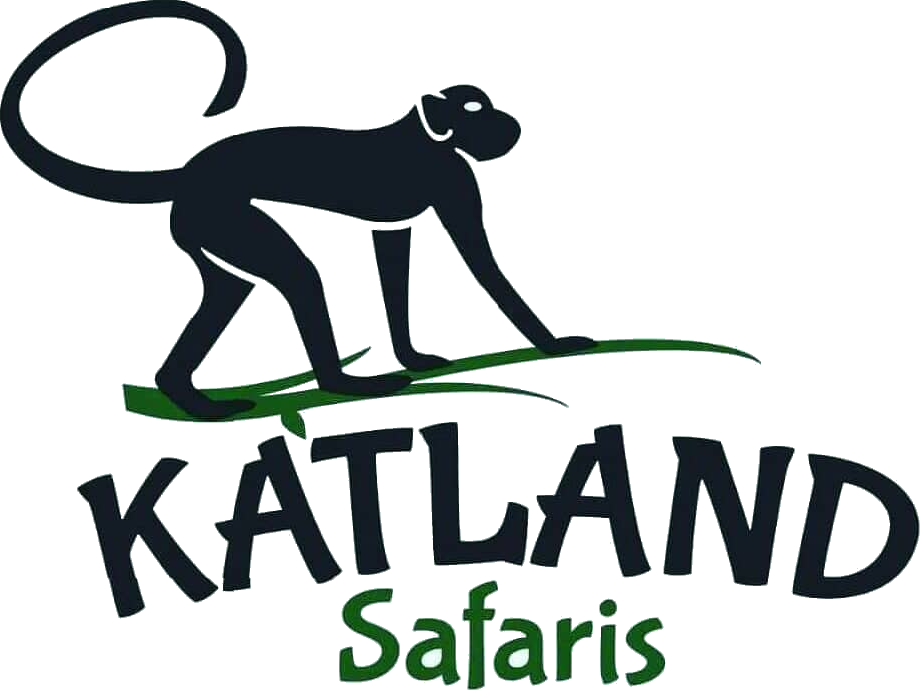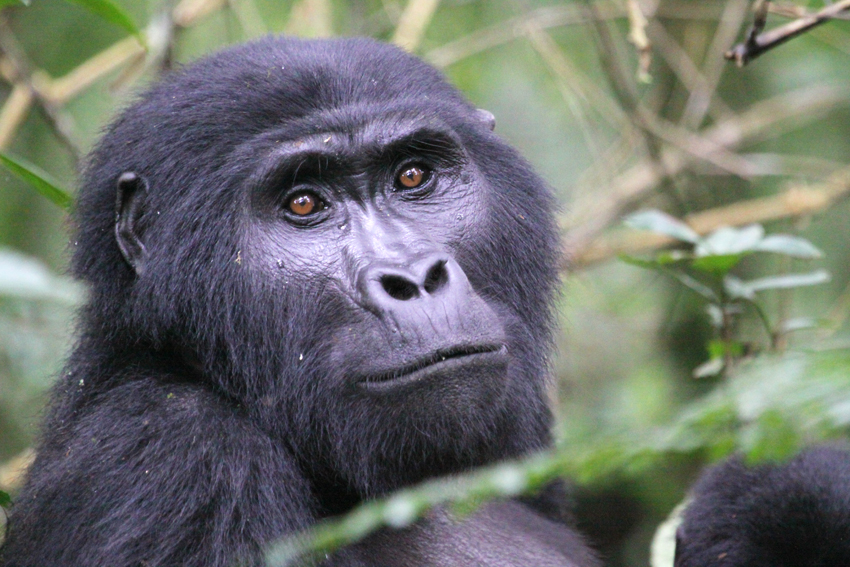Discounted gorilla permits paying off.
In the past, hardly many people traveled to Uganda to hike gorillas, and there was little money available to assist conservation; as a result, gorilla permits were inexpensive, which is now paying off. One strategy to raise awareness of the survival of the world’s last surviving mountain gorillas was to discount Uganda gorilla licenses.
It is thought that mountain gorillas have been there for more than 25,000 years, and they may have existed even before the time of the dinosaurs.
In 2013, the Uganda Wildlife Authority began offering low-season gorilla permits. In April, May, and November, East African residents of Uganda, Kenya, Tanzania, Rwanda, and Burundi would pay Shillings 150000 for each gorilla permit, while foreign residents with a working permit would pay USD 300.00.
The Uganda Wildlife Authority had complained that they were losing money during the wet seasons, therefore this was done to attract more visitors and boost sales during the off-peak months.
During the quiet season, a lot of conservation projects in Bwindi National Park used to go slowly or stop altogether.
The government made the decision to make this offer during Uganda’s 50th anniversary of independence, and it has resulted in a sharp rise in the number of visitors to both Mgahinga National Park and Bwindi Impenetrable National Park. The only places in Uganda where mountain gorillas may be found are here.
More people visited other Ugandan national parks as well. Among these are the Rwenzori Mountains and Murchison Falls National Park, Kibale National Park for chimpanzee trekking and birdwatching, Queen Elizabeth National Park for game drives and boat excursions, and others.
Due to the need of lowering the cost of trip packages, Ugandan tour operators were able to increase their revenue by drawing in additional visitors to supplement the influx of tourists during the peak travel season.
When everything else is equal, Uganda safari facilities like lodging, vehicle rentals, and driver guides often provide savings during the country’s off-peak seasons. Although Uganda’s cheap gorilla permits have already been discontinued, travelers may still get other safari benefits at a reduced cost. Uganda is gradually turning into a reasonably priced travel destination.
The sole issue facing Uganda is the sporadic broadcast of terror warnings. The bombing of Kenya by Alshabab in April 2015 had an impact on the country’s tourism arrivals. Kenya’s stunning beaches and ancient landmarks make it a popular safari destination in Africa, particularly during the big Wildeebest migration.
Terrorists also vowed to attack Uganda during this period, but the nation was able to contain all of these threats due to Ugandans’ security and awareness. Tourist security and safety are, in fact, the top priorities in all tourist sites. Nobody wants to return home in a casket or with injuries.
The Ugandan government established tourism police to especially protect visitors. This included the combined East African visa, which allows one to travel to any country in the region for a fee of $100.00. Rwanda, Burundi, Kenya, Tanzania, and Uganda are some of these nations. D.R. Congo has just joined the community.
You are invited to visit and discover the gem of Africa throughout the off-peak months of April, May, and November, regardless of when you would want to do gorilla trekking in Uganda.
Pressure to expand the number of wildlife staff members grew as global commodity prices began to climb as demand for gorilla trekking also rose. In order to keep up with the rising costs, the gorilla permits also had to be made more expensive.
For international non-residents, a Uganda Gorilla permit now costs $800 per person. Foreign residents pay $700 per person, whereas East African people pay 300,000 Ugandan shillings.
We at Katland Safaris will arrange your transportation, permits, lodging, and reliable travel guidance. Please visit our Trip Advisor page to learn more about our offerings and read reviews from previous customers.
How to Reserve Ugandan Permits for Gorilla Trekking
Decide on a date for your gorilla trekking adventure and the number of individuals you plan to accompany. When you email us a gorilla trekking inquiry with your desired dates, our safari consultant responds with information based on what is available at that moment.
Even if it’s favorable, it doesn’t indicate that availability will stay that way for very long. All interested parties are welcome to book gorilla permits, however money is required since space is limited. The only way to prove your desire to see the mountain gorillas is to get your gorilla permit.
The complete names on your passport, your date of birth, your nationality, the date of your passport’s expiration, and other personal information are later sought. After finishing the gorilla hike, these facts are filled out on the certificate for the Uganda Wildlife Authority’s record-keeping purposes.
Accommodations near your gorilla trekking location are essential, particularly in the impenetrable National Park of Bwindi. This saves you from having to travel far to get to the briefing location.
The four gorilla trekking areas in Bwindi Impenetrable National Park, which is a large jungle, each have their own lodges and gorilla families. Since some gorillas have begun to revert to their natural ways, this allowed visitors to explore every part of the gorilla habitat. It had taken a great deal of effort and money to habituate them. The practice of acclimating wild mountain gorillas to human presence is known as “gorilla habitat.”
It becomes difficult to go between locations for briefings if you choose to go gorilla trekking in one region and stay in another. Buhoma, Ruhijah, Rushaga, and Nkuringo are the four gorilla trekking locations in Bwindi.
Which Ugandan Gorilla Trekking Park Is the Best?
In Uganda, gorilla trekking is limited to Mgahinga National Park and Bwindi Impenetrable National Park.
Because it is the biggest of the four gorilla habitats, Bwindi Impenetrable National Park is home to the greatest number of gorilla families.

There is just one gorilla family, the Nyakagezi, in Mgahinga National Park, which is smaller than Bwindi Forest. Since fewer people are obtaining permits, the forest is still virgin, making this the ideal location for anyone seeking a true gorilla trekking experience.
In the past, the Nyakagezi gorilla family would wander into Rwanda, making it difficult to sell gorilla permits for Mgahinga National Park.
For serious birdwatchers, Mgahinga National Park and Bwindi Impenetrable National Park are both excellent places to go. While Mgahinga woodland is home to around 115 bird species, Bwindi forest is home to over 350 bird species, including Albertine endemics. Since fresh participants are being accepted in the forest, both lists are continually being put together.
The only golden monkeys in Uganda can be found in Mgahinga National Park, whereas chimpanzees can be found in Bwindi Impenetrable National Park. Other primates found in both parks include, but are not limited to, olive baboons, black and white colobus monkeys, grey-cheeked mangabeys, and red-tailed colobus monkeys.
How Challenging Is Ugandan Gorilla Trekking?
The region used for gorilla trekking has a rugged landscape. The whole region was blanketed by volcanic activity, which in some places produced steep mountains.
Depending on the mountain gorillas’ feeding habitat, there may be occasions when trekking is necessary to locate them. The mountain gorillas may graze on the slopes during the intense wet seasons. To get there, you must trek.
Because of the extensive network of rivers that overflow during rainy seasons, the ground surface is sometimes damp. Because of their thick foliage, the trees let in less sunlight.
Gorilla hiking involves following footprints that sometimes pass through tangled creepers, necessitating the ranger guide cutting some off to make a passage.
When Can You Find the Mountain Gorillas?
There is no time limit for finding the mountain gorillas since they are unrestricted free-ranging creatures. It might take two to three quarters of the day after the briefing to locate the mountain gorillas.
Finding mountain gorillas may be fast or challenging depending on their proximity to food and other forest conditions. The gorilla trekking family sometimes engages in combat with a wild family; if they lose, the wild family takes over their feeding area. It might be difficult to locate the gorilla family you are trekking since they are driven into the more remote areas of the jungle.
The mountain gorillas experience grief when a family member dies, which might lengthen their stay in the area. The gorillas must go to a new feeding spot, which may be distant from their known residence, even after the feeding ground has been depleted.
How Perilous Are Gorillas in the Mountains?
Despite their enormous stature, mountain gorillas are calm creatures by nature. When you gaze at them, they become even more bashful. However, because they are wild creatures with emotions of their own, this does not ensure that anybody will contact them.
Mountain gorillas who are agitated may thud their chests, drag grass about them, and even walk on one leg.
In order to prevent a stampede in the jungle, it is prohibited to provoke the mountain gorillas.
Since mountain gorillas are mostly vegetarians, don’t even consider the possibility of their eating on you. Bamboo, soft stems, fruits, and sometimes insects to complement their diet are their delicacies.
How Much Does a Gorilla Trek Package Cost in Uganda?
The remaining elements of a safari package vary, with the exception of the gorilla permit, which is currently $800 per person. The cost of lodging during gorilla trekking is categorized into three categories: luxury, midrange, and budget.
It costs more to hire an experienced and skilled driver guide than it does to hire a driver alone. The cost of the transportation you take to reach the gorillas also varies. A safari van is more expensive than a safari land cruiser.
Given that charter flights are more costly than scheduled flights, even the price of a fly-in gorilla trekking package varies.
What to Bring on a Ugandan Gorilla Trek
To really appreciate this once-in-a-lifetime adventure, gorilla trekking needs a few essential gear.
Sometimes you can trek to the slopes with safari boots that are comfy enough.
a camera to preserve memories of the walk with the mountain gorillas.
Safari clothing has khaki and brown hues that are appropriate for the bush. You need a long-sleeved shirt on top and pants long enough to cover your lower body.
Apply insect repellent to woodland areas to ward against stinging insects.
Energy snacks to eat when you’re hungry while searching for the mountain gorillas.
A backpack, which is waterproof to carry in your stuff and keep them from dispersing.
Toiletries in case the place where you are staying doesn’t have any.
A travel charger and converter in case you need to recharge your electrical devices.
Foldable safari hat to protect your hair from dripping water from the leaves
In case it rains while on the gorilla expedition, bring a raincoat or poncho. so as to avoid being really wet and chilly.
A sweater to keep you warm when it becomes severely chilly when in the bush.
A pair of binoculars to observe far distant things in the jungle like the monkeys, birds and others.
A torch to use when lights go off since most lodges utilize solar energy for illumination.
A duffel bag to hold your possessions.
When in the forest, you may want to cover your hands with garden gloves so you can maintain a stronger grip.
If there are any bugs in your room, use bug repellent.
A first aid kit is necessary in case you get hurt while on safari.
Travel insurance in case of an emergency; some hard cash that you can convert into local currency simply in case you need to buy anything.


